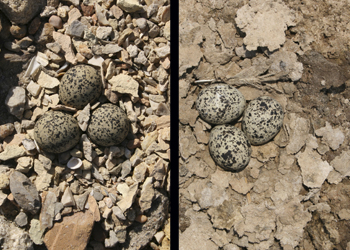In ground-nesting birds egg colour and appearance may have evolved due to opposite selection pressures. Pigmentation and spottiness make the eggs darker and have been suggested to improve camouflage. However darker and more spotted eggs may reach higher temperatures when not attended by adults and receiving direct sunlight, which may be lethal for embryos. Some authors suggested that this trade-off may not exist because eggshell pigments mainly reflect in the infrared region of the solar spectrum, but have not considered that wavelengths in the visible part of the spectrum may also contribute to overheating. To test the occurrence of a trade-off between camouflage and overheating of eggs, digital images were taken to analyse colour and camouflage in 93 nests of four shorebird species in two regions: tropical and mediterranean sites. Authors predicted that these species may have evolved different eggshell designs depending on solar radiation, which is supposed to be stronger in the Tropics. To record egg temperatures, Japanese quail eggs were placed in natural nests of shorebirds, and temperatures were registered using a datalogger. It was found that darker and more spotted eggs reached higher temperatures than lighter ones, and that after controlling for environmental temperatures, eggs overheated more in the Tropics, likely because of a more intense solar radiation. It was also found that tropical shorebirds' eggshells have darker spots and lighter backgrounds. Overall, darker eggs were better camouflaged. Taken together, these results show that the benefits of increasing pigmentation of eggshell backgrounds and spottiness for a better camouflage are counteracted by the increased risks of overheating when eggs remain exposed to direct solar radiation. informacion[at]ebd.csic.es: Gómez et al (2015) A trade-off between overheating and camouflage on shorebird eggshell colouration. J Avian Biol DOI: 10.1111/jav.00736
http://onlinelibrary.wiley.com/doi/10.1111/jav.00736/abstract

 Las altas temperaturas están provocando que las lagunas y las marismas de Doñana pierdan agua rápidamente
Las altas temperaturas están provocando que las lagunas y las marismas de Doñana pierdan agua rápidamente




